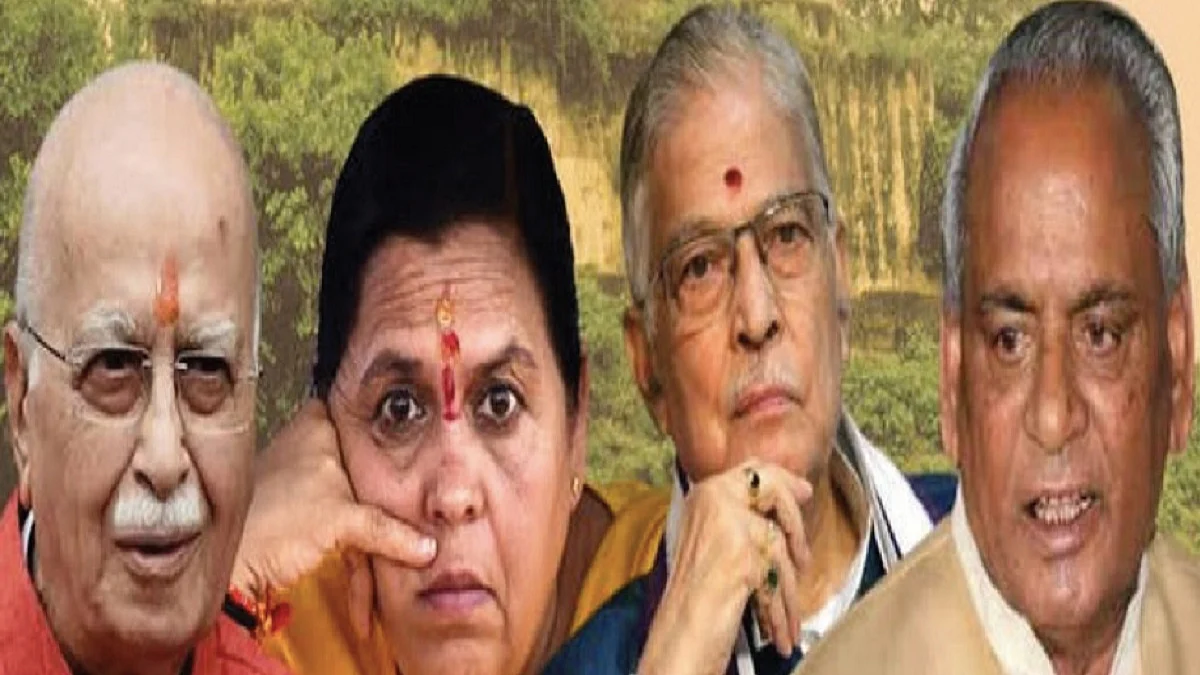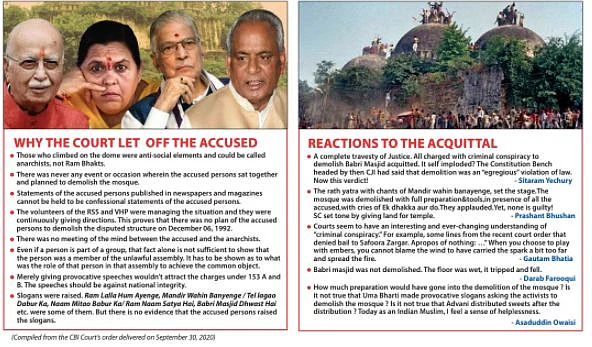How long will RSS, VHP and BJP rest before launching movement to ‘liberate’ Mathura and Kashi ?
‘Yeh toh bus jhaanki hai/ Kashi, Mathura baaki hai’ is what a Babri masjid demolition accused declared after being acquitted by the CBI court in Lucknow. How serious is the threat ?

Minutes after the CBI court judge S.K. Yadav read out the operative part of his judgment on Wednesday, September 30, 2020, acquitting all the accused, the courtroom reverberated with cries of ‘Jai Shri Ram’, the war cry which had been raised between 1989 and 1992, culminating in the demolition of the Babri mosque on December 6, 1992.
The cry was raised by some or all of the 26 accused who were present in the court. Several high-profile accused like Lal Krishna Advani, Dr MM Joshi, Kalyan Singh and Uma Bharti were not present physically in the court; they had been exempted for health reasons and their age. But they were present ‘virtually’ through video-conference.
The CBI judge S.K. Yadav, who had been given three extensions after his retirement to hear this particular case, did not take offence at the slogans being raised though they could have invited penalty. Possibly he was as relieved as the accused were. Or perhaps he was feeling vindicated as did the accused. The case had dragged on for 28 years. As many as 17 of the 49 people accused of conspiring to demolish the 400-year-old mosque, had passed away; and the relief of the survivors was evident as they walked free.
But one of the main accused Acharya Dharmendra struck a discordant note. “Satyameva Jayate. Abhi toh yeh Jhanki hai/ Kashi, Mathura Baaki hai” (Truth always prevails. But this is just the beginning; mission Kashi and Mathura await mobilizing). He was indicating that after Ayodhya, two other mosques at Varanasi and Mathura await demolition.

All three had been on the list of the Vishwa Hindu Parishad and the RSS. Having got away after demolishing the mosque at Ayodhya and with a friendly government, judiciary and media glossing over the unlawful and violent agitations against the mosques, it was not surprising that Acharya Dharmendra would feel tempted to plan Ayodhya-like onslaughts in Kashi and Mathura. While a general of Mughal emperor Babur was accused of demolishing a temple at Ayodhya and build a mosque on top, at Mathura and Kashi it was the Mughal emperor Aurangzeb who was accused of similar acts in the 17th century.
VHP president Alok Kumar, however, dismisses speculation over the impending launch of a political mobilization in Kashi or Mathura. The immediate priority is to build a grand Ram temple at Ayodhya within the next three years. Is the move then being put off for 2023-24? An enigmatic smile is all that reporters get by way of an answer.
Old-timers, however, recall that RSS, VHP and BJP had always maintained that matters of faith could not be settled in a court of law. It was faith which dictated the belief that Ram or Krishna were born at specific spots and litigation was futile to prove or disprove the claim. But that is not deterring the faithful from approaching the court. Taking a cue from the title suit over Ram Jamabhoomi, petitions were filed in both Mathura and Kashi on behalf of deities to get the adjacent mosques removed. Like the Ram Lalla Virajman at Ayodhya, petitions claimed that at Mathura and Kashi also, deities were juridical persons and could own property.
Vijay Shankar Rastogi filed a petition in Varanasi seeking possession of the Gyanvapi Mosque, adjoining Kashi Vishwanath Temple. He claimed to be the best friend of the deity, a trick adopted in Ayodhya case too. Another lawyer Vishnu Jain claimed to be the best friend of Shri Krishna Virajman in Mathura and sought possession of 13.37 acres of land around the Krishna Janmabhoomi. Hours after the CBI court acquitted the accused in the Babri demolition case on September 30, a civil court in Mathura dismissed the petition, citing the Places of Worship (Special Provisions) Act 1991. The Act prohibits any change in the status quo of places of worship that existed when the country became independent on August 15, 1947.
But then neither law nor legal precedents have deterred the Sangh Parivar in the past. And they might not dissuade them in Mathura and Kashi either if they feel it is politically necessary. Even if the Varanasi court follows the precedent set by the civil court in Mathura, there is little guarantee that the country will not witness another Rath Yatra, a fresh spurt in worshipping bricks or another mobilization for ‘Karseva’.
So, while the Babri demolition verdict may not have brought the curtains down on similar Ayodhya-type movements in future, it has certainly brought the curtain down on the political career of most of the 32 accused including Lal Krishna Advani, Murli Manohar Joshi, Uma Bharti, Kalyan Singh and others.
True, barring the sitting MP Sakshi Maharaj, almost all of them have retired from active politics and are in the political doghouse. But a conviction in the Babri Masjid demolition case would have been a badge of honour. They would have been treated as political martyrs, felicitated and taken to courts in grand processions to seek bail. They would have basked under media attention. The acquittal has consigned them, however, to a life of oblivion. Their utility is over. It is finally the end of the road for them.
The verdict may also take attention away from Ayodhya. Ever since the VHP in its first Dharm Sansad organised in Vigyan Bhawan in 1984, resolved to free three shrines from Muslim occupation and rebuild them into grand temples, the focus of national politics has been on Ayodhya. The three shrines were Ram Janmabhoomi Temple (then Babri Masjid) in Ayodhya, Krishna Janmabhoomi Temple (under Shahi Idgah) in Mathura and Kashi Vishwanath temple-Gyanvani Masjid complex in Varanasi. But the acquittal seems to have taken the wind out of Ayodhya’s sails. As a local journalist Trijug Narain Tiwari, tracking developments for past 30 years put it wistfully, “Ayodhya story is finally over.”
The verdict itself was an anti-climax although not completely unexpected. The 2,300-page order didn’t find anybody from RSS, VHP or BJP guilty of conspiracy to demolish the Babri mosque. The judge in his wisdom concluded that the three outfits and their volunteers actually tried to restrain the anti-social elements but failed.
The judgment refused to take cognizance of photographs, video evidence, eyewitness accounts or newspaper reports. The VHP, Bajrang Dal and BJP volunteers were ‘ Ram Bhakts’ and wanted to protect the structure which also had an idol of Ram. The judge clearly believed that Ram Bhakts were outnumbered on the day by infiltrators. At the same time, the order also mentioned that the demolition was a spontaneous act by a section of Kar sevaks. The judge also brushed aside eyewitnesses deposing that VHP leader Uma Bharti raised provocative slogans like ‘Ek dhakka aur do, Babri Masjid tod do’. She even exhorted the kar sevaks to lie down on the road to block the way of Central security forces rushed from Faizabad.
SK Yadav, who got three extensions to complete the trial and give the judgement, relied upon local intelligence reports. LIU report (Exhibit number 150) dated December 2, 1992, spoke of Muslim leaders like Mohd Hashim Ansari and Haji Mehboob trying to incite Muslims. Another LIU report (Exhibit number 151) dated December 3, 1992 claimed that anti-social Muslim elements had damaged old graves.
The judgement raised more questions than it answered. How did over 10 lakh people gather there and on that very day? Why were a large number of them armed with shovels, pic-axes and other equipment used in the demolition? How were a group of youth allowed to rehearse the demolition for several days before the demolition? Surely such rehearsals could not have been spontaneous?
The judge also ignored the role of rabble-rousers like Sadhvi Ritambhara, Acharya Dharmendra etc. who through pre-recorded cassettes, spread hatred, exhorting Hindus to demolish the mosque and annihilate Muslims? The incendiary cassettes often began or ended with the slogan- Jis Hindu ka khoon na khaula, khoon nahin vo paani hai.
He also brushed aside the role of the then Uttar Pradesh Chief Minister Kalyan Singh, who had submitted a sworn affidavit in the supreme court promising to protect the mosque. He failed in the task and was sent to jail for a day.
While legal experts who have read the long order cursorily so far are of the opinion that the CBI should file an appeal in the High Court, it seems highly unlikely that the central agency, a caged parrot more than ever, will challenge the order. First the Supreme Court went out of its way to settle the title suit in November last year. And now with the acquittal of the accused in the criminal case, the Ayodhya story has finally been buried.
Are more surprises in store?
Follow us on: Facebook, Twitter, Google News, Instagram
Join our official telegram channel (@nationalherald) and stay updated with the latest headlines